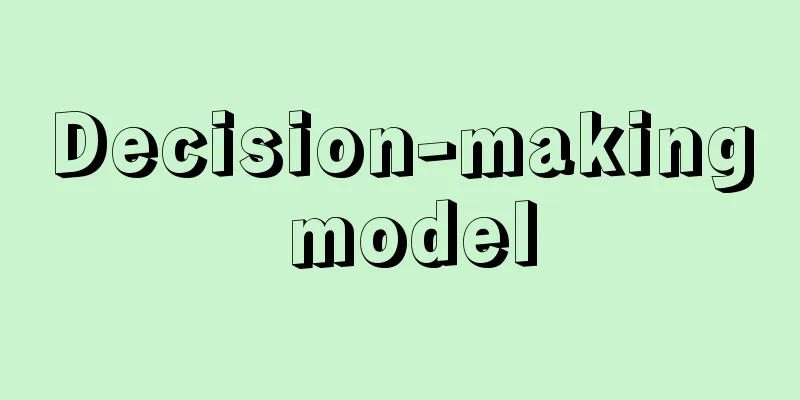Decision-making model

"Can you build a model to analyze how to make a decision?" is a question often asked at work, which also makes many data analysts feel overwhelmed. "How can I make this decision? Can I still build a model? Why don't you let me go and have my fortune told?" is a common complaint. In fact, there is a model for data-driven decision-making, but there are many prerequisites and restrictions. Today I will share with you a systematic approach. After reading it, you will find that even if you only master the process of combing the model, it is very helpful! 01 Prerequisites for Model BuildingEnterprises make decisions in a fixed pattern:
We can represent this process as follows: The biggest difference between scientific decision-making and fortune-telling is that scientific decision-making is based on data and never guesses . If you don’t understand the situation at present, you must first do a descriptive analysis to clarify the situation, which is the premise for building a model. For example, if a company uses a public account to acquire customers, the historical exposure, conversion data, and available delivery times are recorded as follows. How can we build an analysis model? (As shown in the figure below): The answer is no! Because a lot of basic information is missing: 1. What is the decision-making goal? Control costs? Increase customer acquisition? 2. What are the constraints? How much investment funds does our company have? 3. Do I have to invest XX times in certain channels? If you don’t know these basic conditions, you certainly can’t model it. Supplementing the basic information is the first step. 02 Model building processAssume that the information is complete: 1. Goal: Acquire the largest number of customers. 2. Constraints: Total investment cost 30,000 yuan. 3. Constraints: There is no limit on the number of specific channels. 4. Factors to be decided: how many times each channel is delivered. Now we can start modeling. Let’s first convert the business description into a mathematical description (as shown below): After that, you can build a linear programming model to find the optimal solution. Many tools can be used to find the optimal solution. For example, Excel has its own planning and solving function. Python can use the scipy.optimize.linprog function to solve it. Here is a simple example using Excel. As long as you put the goal, constraints, and factors to be solved into the grid, you can automatically calculate the optimal solution (as shown in the figure below, it is automatically displayed in the cell, that is, the maximum number of customers under the constraint of 30,000 is 4,295). After sorting out the logic, you can calculate the answer in just a few simple steps. It is very easy to use. 03 How to use the modelNote! Even without a model, you can still do the processing manually. Generally, students who do advertising will use the advertising cost of each channel/the number of customers to calculate the cost of acquiring customers per unit (CAC), and then see which channel has the lowest customer acquisition cost. They will first invest in this channel, and then see how much money is left on hand and continue to invest in the second lowest cost. The whole operation is shown in the following figure (as shown below): Why do we need to build a model if we can do it manually? Answer: Because it is convenient to calculate after building a model. For example: 1. Modify the goal: The goal is changed to achieving the goal of acquiring 4,000 customers with the lowest cost. 2. Modification conditions: The quotation and frequency of channels A and B are adjusted. 3. Add new options: Add channels F, G, and H and consider them together. … When the situation changes, you can adjust the model parameters and output the results directly, which is much more efficient than manual arrangement. Seeing this, some students may ask: If the model is so useful, why is it rarely mentioned? Because in real work, there are often problems that restrict the establishment of models, such as... 03 Constraints of the ModelConstraint 1: Collection of basic datafor example: 1. What is the basic production capacity of our equipment? 2. How many people do we have in sales and what is the average output per person? 3. How big is the difference between the best and the worst? 4. Is the performance stable? Are there seasonal differences? These basic data collection and analysis conclusions are very important. Only by mastering the basic data can we build models. In many cases, descriptive statistics are not done well, and people just look at the average and blindly make decisions, which can easily lead to the mistake of "gathering 10 pregnant women will give birth to a baby in one month". Constraint 2: Clear business objectivesUnclear goals are a common problem for enterprises, for example: 1. The leader said: "See how you can optimize it"... There is no goal at all. 2. Before the analysis, they say: "The budget is OPEN"; after the analysis, they say: "The investment is too large, you have to consider the actual situation." 3. After analysis, we can minimize the input, maximize the output, achieve the highest efficiency, and also... If the goal does not exist or is very confusing, you will not be able to write the model formula, let alone solve the model. If there are a lot of goals, the model will be unsolvable. In linear programming methods, there is a two-stage method that can solve the optimal solution for dual goals, but based on experience, there is generally a 50% probability that there is no solution. Because the model is just a simulation of the business situation, not magic, it cannot make your originally poor business become invincible... In general, when there are multiple goals, we recommend focusing on one main goal and turning the others into constraints. For example: Before optimization: Minimize cost and maximize revenue, this is a typical dual goal! It sounds painful. After optimization: When the cost is less than XXX thousand, the income is maximized. By changing the dual objectives into conditions, not only can the optimal solution be found, but also through testing, the cost limit under the current constraints can be found (if the limit is exceeded, the optimal solution that meets expectations cannot be found), which in turn drives the business to improve its operational capabilities. Constraint 3: Stable business performanceIn the modeling process, it is assumed that the parameters are fixed. This is more difficult on the marketing side, because user response rate is often a metaphysical problem. Therefore, linear programming models are more commonly used on the production side. Because the performance of equipment on the production side often has fixed parameters, and the production side has clear goals (maximum output at a given cost/minimum cost for a given output). On the marketing side, classification models or response models are often used. In summary, the process of building a model is far more valuable than the model itself. In the process of building a model, problems with data collection, confusion of goals, unclear thinking, and business regularity will be exposed, which can greatly assist decision-making and help us return to an objective and rational path. Author: Down-to-earth Teacher Chen; WeChat public account: Down-to-earth Teacher Chen |
<<: Why is there always marketing backlash in recent years?
>>: My opinion on Dong Yuhui's sudden deletion of his Weibo account
Recommend
How does Shopee send offline logistics? How to complete the delivery?
After Shopee places an order, the merchant needs t...
5 cultural tourism marketing cases that will be popular in 2023: From Zibo to Tianjin, where will become the next Harbin?
Phenomenal cases can often provide insights into i...
What's the problem with Huaxizi?
Let's talk about brand and marketing separatel...
Are Amazon Outlets promotions effective? How do they work?
Merchants who run stores on Amazon often use outle...
eBay Australia to reduce Orange Connex delivery fees
eBay Australia recently announced that before Janu...
Product data analysis: optimize product strategy and improve sales conversion
The article discusses in depth how to optimize you...
Is Amazon's no-source cross-border e-commerce reliable? Is it worth doing?
Speaking of cross-border e-commerce platforms, I b...
After reviewing our 60-day startup, we have learned three things:
In a highly competitive business environment, how ...
Douyin joins the e-commerce platform "Hourly Delivery", and instant delivery is open!
In today's fierce competition among e-commerce...
How to change the background of Shopee live broadcast? How to do live broadcast well?
Now more and more friends realize that cross-borde...
Will the Spring Festival affect Amazon Japan? What should I pay attention to?
Nowadays, many friends will buy products online. A...
Why does marketing to women always fail?
The discussion about feminism has become increasin...
Measuring “grass planting”, Xiaohongshu wants to make more money
As Xiaohongshu continues to explore and accelerate...
How to use Shopee Wallet? Where to open it?
Merchants who open stores on the Shopee platform w...
The new decade of second-hand e-commerce
In the new decade of the second-hand e-commerce in...









